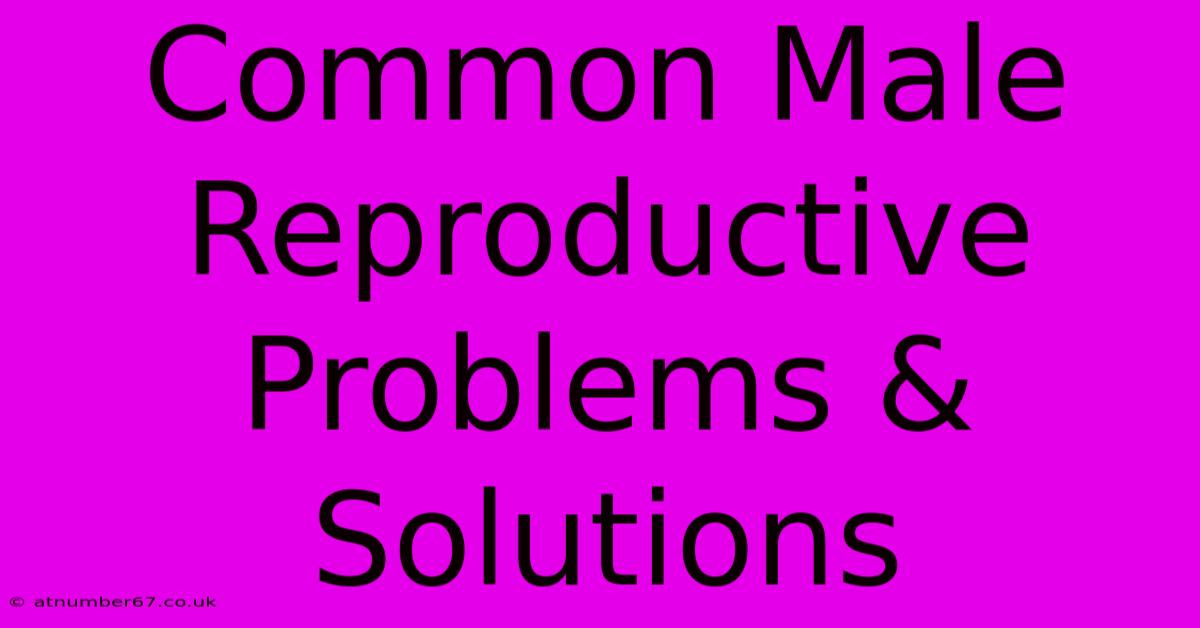Common Male Reproductive Problems & Solutions

Table of Contents
Common Male Reproductive Problems & Solutions
Male reproductive health is a crucial aspect of overall well-being, impacting fertility, sexual function, and overall quality of life. Many men experience reproductive issues at some point in their lives, ranging from minor inconveniences to serious conditions requiring medical intervention. Understanding common problems and their potential solutions is vital for proactive health management.
Common Male Reproductive Problems: A Comprehensive Overview
This section explores some of the most frequently encountered male reproductive problems:
1. Erectile Dysfunction (ED):
Erectile dysfunction, also known as impotence, is the inability to achieve or maintain an erection firm enough for satisfactory sexual intercourse. Several factors contribute to ED, including:
- Physical causes: Cardiovascular disease, diabetes, high blood pressure, nerve damage, hormonal imbalances, and certain medications.
- Psychological causes: Stress, anxiety, depression, and relationship problems.
- Lifestyle factors: Smoking, excessive alcohol consumption, obesity, and lack of physical activity.
Solutions: Treatment options vary depending on the underlying cause and may include lifestyle changes (diet, exercise, stress management), medication (oral medications like phosphodiesterase-5 inhibitors, injections), or surgery (penile implants). It's crucial to consult a doctor for proper diagnosis and personalized treatment.
2. Infertility:
Male infertility refers to the inability to conceive a child. Various factors can contribute to infertility, including:
- Low sperm count (oligospermia): A lower-than-normal number of sperm in the ejaculate.
- Poor sperm motility (asthenospermia): Sperm's inability to move effectively.
- Abnormal sperm morphology (teratospermia): Sperm with irregular shapes.
- Varicocele: Enlarged veins in the scrotum.
- Hormonal imbalances: Problems with testosterone production or other hormones.
- Blockages in the reproductive tract: Obstructions preventing sperm from reaching the ejaculatory duct.
Solutions: Treatment options depend on the specific cause and might involve lifestyle changes, medication to correct hormonal imbalances, surgery to repair varicoceles or blockages, assisted reproductive technologies (ART) like in-vitro fertilization (IVF), or intrauterine insemination (IUI). A thorough evaluation by a fertility specialist is essential.
3. Prostatitis:
Prostatitis is inflammation of the prostate gland, causing symptoms like pain in the pelvic area, difficulty urinating, and painful ejaculation. Types of prostatitis include:
- Acute bacterial prostatitis: A sudden, severe infection requiring antibiotic treatment.
- Chronic bacterial prostatitis: A recurring infection that may require long-term antibiotic therapy.
- Chronic prostatitis/chronic pelvic pain syndrome: A non-bacterial inflammation with less clear causes, often managed with pain relief and lifestyle modifications.
Solutions: Treatment varies depending on the type of prostatitis and often involves antibiotics (for bacterial infections), pain relievers, alpha-blockers (to improve urine flow), and lifestyle changes.
4. Testicular Cancer:
Testicular cancer is a relatively rare cancer affecting the testicles. Early detection is crucial for successful treatment. Symptoms include a lump or swelling in the testicle, pain or discomfort in the scrotum, and a feeling of heaviness in the scrotum.
Solutions: Treatment options depend on the stage of cancer and may include surgery (orchiectomy), chemotherapy, radiation therapy, or a combination of these methods. Regular self-exams and prompt medical attention are essential.
5. Low Testosterone (Hypogonadism):
Low testosterone levels can lead to decreased libido, erectile dysfunction, fatigue, decreased muscle mass, and mood changes. Several factors can cause low testosterone, including aging, certain medical conditions, and medications.
Solutions: Treatment options may include testosterone replacement therapy (TRT), lifestyle changes, and addressing underlying medical conditions. TRT should be carefully monitored by a doctor due to potential side effects.
Seeking Help and Maintaining Reproductive Health
Addressing male reproductive problems requires proactive steps:
- Regular checkups: Schedule regular visits with your doctor for general health checkups, including discussions about reproductive health.
- Open communication: Talk openly with your doctor about any concerns or symptoms you experience.
- Lifestyle modifications: Maintain a healthy lifestyle through balanced diet, regular exercise, stress management, and avoiding smoking and excessive alcohol consumption.
- Self-exams: Perform regular testicular self-exams to detect any abnormalities early.
This information is for general knowledge and does not constitute medical advice. Always consult with a healthcare professional for diagnosis and treatment of any male reproductive health issues. Early detection and intervention are key to improving outcomes and maintaining overall well-being.

Thank you for visiting our website wich cover about Common Male Reproductive Problems & Solutions. We hope the information provided has been useful to you. Feel free to contact us if you have any questions or need further assistance. See you next time and dont miss to bookmark.
Featured Posts
-
Naomi Watts Son Kai A Story Of Perseverance
Apr 14, 2025
-
Best Dad Jokes 2024 Perfect For Dads Day
Apr 14, 2025
-
Faiq Bolkiahs Net Worth The Numbers Dont Lie
Apr 14, 2025
-
Post Malones Net Worth Learn From His Success
Apr 14, 2025
-
Women Age Live Your Best Life Yet
Apr 14, 2025
